
In the past, motor repair meant dealing with traditional three-phase motor failures that were largely the result of water, dust, grease, failed bearings, misaligned motor shafts, or just plain old age. But motor repair has changed in a big way with the introduction of electronically controlled motors, more commonly referred to as adjustable speed drives (ASDs). These drives present a unique set of measurement problems that can vex the most seasoned pro. Thanks to new technology, now for the first time you can take accurate electrical measurements with a DMM during the installation and maintenance of a drive and diagnose bad components and other conditions that may lead to premature failure.
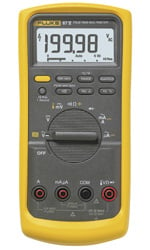
Troubleshooting philosophy
Technicians use many different methods to troubleshoot an electrical circuit, and a good troubleshooter will always find the problem - eventually. The trick is tracking it down quickly and keeping downtime to a minimum. The most efficient troubleshooting procedure begins at the motor and then works systematically back to the electrical source, looking for the most obvious problems first. A lot of time and money can be wasted replacing perfectly good parts when the problem is simply a loose connection. As you go, take care to take accurate measurements. Nobody takes inaccurate measurements on purpose, but it's easy to do, especially when working in a high energy, noisy environment like an ASD. Likewise, choosing the right test tools for troubleshooting the drive, the motor, and the connections is of utmost importance. This is especially true when taking voltage, frequency and current measurements on the output side of the motor drive. But until now, there hasn't been a digital multimeter on the market able to accurately measure ASDs. Fluke's new version of the popular Fluke 87 DMM, the 87V, incorporates a selectable low pass filter* that allows for accurate drive output measurements that agree with the motor drive controller display indicator. Now, technicians won't have to guess whether the drive is operating correctly and delivering the correct voltage, current or frequency for a given control setting.
Drive measurements
Input side measurements
Any good quality True RMS multimeter can verify proper input power to an ASD. The input voltage readings should be within 1% of one another when measured phase to phase with no load. A significant unbalance may lead to erratic drive operation and should be corrected when discovered.
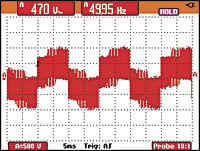
Output side measurements
On the flip side, a regular true-rms multimeter can't reliably read the output side of a pulse width modulated (pwm) motor drive, because the ASD applies pulse width modulated nonsinusoidal voltage to the motor terminals. A True RMS DMM reads the heating effect of the non-sinusoidal voltage applied to the motor, while the motor controller's output voltage reading only displays the rms value of the fundamental component (typically from 30 Hz to 60 Hz). The causes of this discrepancy are bandwidth and shielding. Many of today's true-rms digital multimeters have bandwidths out to 20 kHz or more, causing them to respond not only to the fundamental component, which is what the motor really responds to, but to all of the high frequency components generated by the pwm drive. And if the DMM isn't shielded for high frequency noise, the drive controller's high noise levels make the measurement discrepancies even more extreme. With the bandwidth and shielding issues combined, many true-rms meters display readings as much as 20 to 30% higher than what the drive controller is indicating. Fluke's new 87V multimeter, with its newly incorporated selectable low pass filter, allows troubleshooters to take accurate voltage, current and frequency measurements on the output side of the drive at either the drive itself or the motor terminals. With the filter selected, the 87V readings for both voltage and frequency (motor speed) should agree with the associated drive control display indications, if available. The low pass filter also allows for accurate current measurements when used with Hall-effect type clamps. All of these measurements are especially helpful when taking measurements at the motor location when the drive's displays are not in view.
Taking safe measurements
Before taking any electrical measurements, be sure you understand how to take them safely. No test instrument is completely safe if used improperly, and many test instruments are not appropriate for testing adjustable speed drives. Also make sure to use the appropriate personal protective equipment (PPE) for your specific working environment and measurements. If at all possible, never work alone.
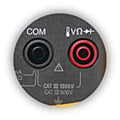

Safety ratings for electrical test equipment
ANSI and the International Electrotechnical Commission (IEC) are the primary independent organizations that define safety standards for test equipment manufacturers. The IEC 61010 second edition standard for test equipment safety states two basic parameters: a voltage rating and a measurement category rating. The voltage rating is the maximum continuous working voltage the instrument is capable of measuring. The category ratings depict the measurement environment expected for a given category. Most three-phase ASD installations would be considered a CAT III measurement environment, with power supplied from either 480V or 600V distribution systems. When using a DMM for measurements on these high energy systems, make sure it's rated at a minimum for CAT III 600V and preferably for CAT IV 600V/CAT III 1000V. The category rating and voltage limit are typically found on the front panel, at the input terminals. The new Fluke 87V is dual-rated CAT IV 600V and CAT III 1000V. Refer to the ABC's of DMM Safety* from Fluke for additional information on category ratings and taking safe measurements.
Taking the measurements
Now let's put Fluke's new 87V DMM to the test. The measurements in the following procedure are designed to be made on a 480 volt 3 phase drive control at the control panel terminal strips, using the 87V. These procedures would also be valid for lower voltage 3 phase drives powered by either single or 3 phase supply voltages. For these tests the motor is running at 50 Hz.

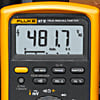
Input voltage
To measure the ac voltage supply to the input side of the drive at the drive:
- Select the 87V's ac voltage function.
- Connect the black probe to one of the three phase input terminals. This will be the reference phase.
- Connect the red probe to one of the other two phase input terminals and record the reading.
- Leaving the black probe on the reference phase now move the red probe to the third phase input and record this reading.
- Make sure there's no more than a 1% difference between these two readings.
Input current
Measuring the input current generally requires a current clamp accessory. In most cases, either the input current exceeds the maximum current measurable by the 87V's current function, or it isn't practical to "break the circuit" to take an in-line series current measurement. Regardless of clamp type, insure that all readings are within 10% of each other for proper balance.
Transformer type clamp (i200, 80i-400, 80i-600A)
- Connect the clamp to the 87V's common and 400 mA input jacks.
- Select the mA/A AC function.
- Place the clamp around each of the input supply phase cables in succession, recording each of the readings as they are taken. Since these clamps output one milliamp per amp, the milliamp readings shown on the 87V display are the actual phase current readings in amps.

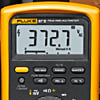
Hall Effect type (AC/DC) clamp (i410,i-1010)
- Connect the clamp to the 87V's common and V/W input jacks.
- Select the 87V's AC voltage function.
- Press the yellow button to enable the low pass filter. This allows the meter to reject all of the high frequency noise generated by the drive controller. Once the low pass filter is enabled, the meter will be in the 600mV manual range mode.
- Place the clamp around each of the input supply phase cables in succession, recording each of the readings as they are taken. Since these clamps output one millivolt per amp, the millivolt readings shown on the 87V display are the actual phase current readings in amps.
Output voltage
To measure the AC output voltage at either the drive or the motor terminals:
- Plug the black test lead into the common jack and the red test lead into the V/W jack.
- Select the 87V's AC voltage function.
- Connect the black probe to one of the three phase output voltage or motor terminals. This will be the reference phase.
- Connect the red probe to one of the other two phase output voltage or motor terminals.
- Press the yellow button to enable the low pass filter. Now record the reading.
- Leaving the black probe on the reference phase, now move the red probe to the third phase output voltage or motor terminal and record this reading.
- Make sure that there's no more than a 1 % difference between these two readings (see Figure 2). The readings should also agree with the controller display, panel if available.
- If the low pass filter isn't enabled, the output voltage readings may be 10 to 30% higher, as on a regular DMM (see Figure 1).
Motor speed (Output frequency using voltage as a reference)
To determine motor speed, simply take a frequency measurement while using the low pass filter. The measurement can be made between any two of the phase voltage or motor terminals.

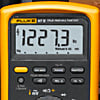
- Plug the black test lead into the common jack and the red test lead into the V/W jack.
- Select the 87V's ac voltage function.
- Connect the black probe to one of the three phase output voltage or motor terminals. This will be the reference phase.
- Connect the red probe to one of the other two phase output voltage or motor terminals.
- Press the yellow button to enable the low pass filter.
- Press the Hz button. The displayed reading in hertz will be the motor speed (see Figure 3). This measurement couldn't be made successfully without the 87V's low pass filter (see Figure 4).


Output current
As with input current, measuring the output current generally requires a current clamp accessory. Once again, regardless of clamp type, insure that all readings are within 10% of each other for proper balance.
Transformer type clamp (i200, 80i-400, 80i-600A)
- Connect the clamp to the 87V's common and 400 mA input jacks.
- Select the mA/A ac function.
- Place the clamp around each of the output phase cables in succession, recording each of the readings as they're taken. Since these clamps output 1 milliamp per amp, the milliamp readings shown on the 87V display are the actual phase current readings in amps.


Hall Effect type (AC/DC) clamp (i410,i-1010)
- Connect the clamp to the 87V's common and V/W input jacks.
- Select the 87V's ac voltage function.
- Press the yellow button to enable the low pass filter. This allows the meter to reject all of the high frequency noise generated by the drive controller. Once the low pass filter is turned on, the meter will be in the 600 mV manual range mode.
- Place the clamp around each of the output phase cables in succession, recording each of the readings as they are taken (see Figure 6). Since these clamps output 1 millivolt per amp, the millivolt readings shown on the 87-V display are the actual phase current readings in amps. This measurement would not be possible without the 87V's low pass filter (see Figure 5).
Motor speed (Output frequency using current as a reference)
For motors that pull at least 20 amps of running current, motor speed can be determined by taking a frequency measurement with current clamps. Until now, noise issues have prevented accurate readings using hall effect type clamps. Here's how the low pass filter makes it possible.
Motor speed using a Hall Effect type (AC/DC) clamp (i410,i-1010)
- Connect the clamp to the 87V's common and V/W input jacks.
- Select the 87V's ac voltage function.
- Press the yellow button to enable the low pass filter. This allows the meter to reject all of the high frequency noise generated by the drive controller. Once the low pass filter has been turned on, the meter will be in the 600 mV manual range mode.
- Place the clamp around one of the output phase cables. Verify that the 87V is reading a current of at least 20 amps (20 mV in the display).
- Press the Hz button. The readings now display the motor speed as a frequency measurement.

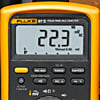
Motor speed using a transformer type clamp (i200, 80i-400, 80i-600A)
- Connect the clamp to the 87V's common and 400 mA input jacks.
- Select the mA/A AC function.
- Place the clamp around one of the output phase cables. Verify that the 87V is reading a current of at least 20 amps (20mA in the display).
- Press the Hz button. The readings now display the motor speed as a frequency measurement.
DC Bus measurements
A healthy dc bus is a must for a properly operating motor drive. If the bus voltage is incorrect or unstable, the converter diodes or capacitors may be starting to fail. The DC bus voltage should be approximately 1.414 times the phase to phase input voltage. For a 480 volt input, the DC bus should be approximately 679 VDC. The DC bus is typically labeled as DC+, DC- or B+, Bon the drive terminal strip. To measure the DC bus voltage:
- Select the 87V's dc voltage function.
- Connect the black probe to either the DC- or B- terminal.
- Connect the red probe to the DC+ or B+ terminal.
The bus voltage should agree with the example mentioned above and be relatively stable. To check the amount of ac ripple on the bus, switch the 87V's function switch to the vac function. Some small drives don't allow external access to the DC bus measurement without disassembling the drive. If you can't access the DC bus, use the peak min max function on the 87V to measure the dc bus voltage via the output voltage signal. - Plug the black test lead into the common jack and the red test lead into the V/½ jack.
- Select the 87V's AC voltage function.
- Connect the black probe to one of the three phase output voltage or motor terminals. This will be the reference phase.
- Connect the red probe to one of the other two phase output voltage or motor terminals.
- Press the MIN MAX button.
- Press the
 (Peak min max) button.
(Peak min max) button. - The displayed reading in Peak min max will be the DC bus voltage.
 (Peak min max) button.
(Peak min max) button.